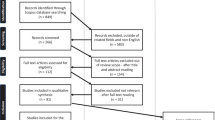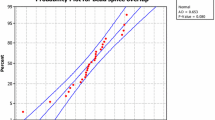Abstract
The implementation of lean manufacturing (LM) means a systematic approach of various management methods and practices, which may influence individuals’ job content and the quality of work. However, research related to socio-technical and ergonomics (SE) factors has for a long time solely focused on regular production work to a large extent. This study aims to assess the relationship between LM and SE practices in companies undergoing a lean implementation. The proposed method comprises a combination of techniques that allow the identification of deficiencies related to the adoption of LM practices that may support SE practices implementation, indicating a prioritization of improvements opportunities to better sustain them. Further, through the establishment of the degree of criticality of LM practices, our outcomes allow to identify implementation gaps in the lean process that are highly related with the current status of socio-technical and ergonomics improvements in the company, anticipating problems and developing the practices that converge to them.
Similar content being viewed by others
References
Seppälä P, Klemola S (2004) How do employees perceive their organization and job when companies adopt principles of lean production? Hum Factors Ergon Manuf Serv Ind 14(2):157–180. doi:10.1002/hfm.10059
Womack J, Jones D (1996) Lean thinking: banish waste and create wealth for your corporation. Simon and Schuster, New York
Marodin G, Saurin T (2013) Implementing lean production systems: research areas and opportunities for future studies. Int J Prod Res 51(22):6663–6680. doi:10.1080/00207543.2013.826831
Bhamu J, Singh Sangwan K (2014) Lean manufacturing: literature review and research issues. Int J Oper Prod Manag 34(7):876–940. doi:10.1108/IJOPM-08-2012-0315
Shah R, Ward P (2003) Lean manufacturing: context, practice bundles, and performance. J Oper Manag 21(2):129–149. doi:10.1016/S0272-6963(02)00108-0
Getty L (1999) Ergonomics and the customer satisfaction model: ergonomics in the language of business. Proc Hum Factors Ergon Soc Annu Meet 43(14):815–819. doi:10.1177/154193129904301401
Arezes P, Dinis-Carvalho J, Alves A (2015) Workplace ergonomics in lean production environments: a literature review. Work 52(1):57–70. doi:10.3233/WOR-141941
Eklund J (2000) Development work for quality and ergonomics. Appl Ergon 31(6):641–648. doi:10.1016/S0003-6870(00)00039-9
IEA (2000) The discipline of ergonomics. Available at: www.iea.cc. Accessed 05 may 2016
Dul J, Neumann W (2009) Ergonomics contributions to company strategies. Appl Ergon 40(4):745–752. doi:10.1016/j.apergo.2008.07.001
Bäckstrand G, Bergman C, Hogberg D, Moestam L (2013) Lean and its impact on workplace design. Proceedings of NES 45th Nordic Ergonomics & Human Factors Society Conference, Iceland
Toralla P, Falzon P, Morais A (2012) Participatory design in lean production: which contribution from employees? For what end? Work 41:2706–2712. doi:10.3233/WOR-2012-0514-2706
Saurin T, Ferreira C (2009) The impacts of lean production on working conditions: a case study of a harvester assembly line in Brazil. Int J Ind Ergon 39:403–412. doi:10.1016/j.ergon.2008.08.003
Fiore C, (2016) Lean execution: the basic implementation guide for maximizing process performance. CRC Press, Taylor & Francis Group
Macleod I (2003) Real-world effectiveness of ergonomic methods. Appl Ergon 34:465–477. doi:10.1016/S0003-6870(03)00066-8
Lean Y, Shan F (2012) Brief review on physiological and biochemical evaluations on human mental workload. Hum Factors Ergon Manuf Serv Ind 22:177–187. doi:10.1002/hfm.20269
Zink K (2000) TQM in Germany: experiences and perspectives concerning ergonomics. Proc Hum Factors Ergon Soc Annu Meet 44(12):472–475. doi:10.1177/154193120004401210
Tortorella G, Fries C, da Silva M, Amaral F, Fogliatto F (2015) Gaps between psychophysical demands and perceived workload—a framework for lean production system. Proceedings of 2015 International Conference on Operations Excellence and Service Engineering, Orlando, Florida, USA, September 10-11th
Koukoulaki T (2014) The impact of lean production on musculoskeletal and psychosocial risks: an examination of sociotechnical trends over 20 years. Appl Ergon 45:198–21. doi:10.1016/j.apergo.2013.07.018
Munck-Ulfsfält U, Falck A, Forsberg A, Dahlin C, Eriksson A (2003) Corporate ergonomics programme at Volvo car corporation. Appl Ergon 34(1):17–22
Joseph S (2003) Corporate ergonomics programme at ford motor company. Appl Ergon 34(1):23–28. doi:10.1016/S0003-6870(02)00079-0
Genaidy A, Karwowski W (2003) Human performance in lean production environment: critical assessment and research framework. Hum Factors Ergon Manuf Serv Ind 13(4):317–330. doi:10.1002/hfm.10047
Beevis D (2003) Ergonomics: cost and benefits revisited. Appl Ergon 34:491–496. doi:10.1016/S0003-6870(03)00068-1
Hagg G (2003) Corporate initiatives in ergonomics: an introduction. Appl Ergon 34:3–15. doi:10.1016/S0003-6870(02)00078-9
Tortorella G, Fogliatto F (2014) Method for assessing human resources management practices and organisational learning factors in a company under lean manufacturing implementation. Int J Prod Res 52(15):4623–4645. doi:10.1080/00207543.2014.881577
Fraser P, Moultrie J, Gregory M (2002) The use of maturity models/grids as a tool in assessing product development capability. IEEE 1:244–249. doi:10.1109/IEMC.2002.1038431
Capaldo D, Rozenfeld H (2007) Integrating new product development process references with maturity and changes management. ICED ‘07, Paris-FR, August
Longoni A, Pagell M, Johnston D, Veltri A (2013) When does lean hurt?—an exploration of lean practices and worker health and safety outcomes. Int J Prod Res 51(11):3300–3320. doi:10.1080/00207543.2013.765072
Ketokivi M, Schroeder R (2004) Manufacturing practices, strategic fit and performance: a routine-based view. International Journal of Operations & Production Management 24(2):171–191. doi:10.1108/01443570410514876
Herron C, Braiden P (2006) A methodology for developing sustainable quantifiable productivity improvement in manufacturing companies. Int J Prod Econ 104:143–153. doi:10.1016/j.ijpe.2005.10.004
Pavnascar S, Gershenson J, Jambekar A (2003) Classification scheme for lean manufacturing tools. Int J Prod Res 13:3075–3090. doi:10.1080/0020754021000049817
Bhasin S, Burcher P (2006) Lean viewed as a philosophy. J Manuf Technol Manag 17(1):56–72. doi:10.1108/17410380610639506
Doolen T, Hacker M (2005) A review of lean assessment in organizations: an exploratory study of lean practices by electronics manufacturers. Journal of Manufacturing System Singh s 24(1):55–67
Stentoft A, Vagn F (2013) Evidence of lean: a review of international peer-reviewed journal articles. Eur Bus Rev 25(2):174–205. doi:10.1108/09555341311302675
Shah R, Ward P (2007) Defining and developing measures of lean production. J Oper Manag 25:785–805. doi:10.1016/j.jom.2007.01.019
Bortolotti T, Boscari S, Danese P (2015) Successful lean implementation: organizational culture and soft lean practices. Int J Prod Econ 160:182–201. doi:10.1016/j.ijpe.2014.10.013
Furlan A, Vinelli A, Dal Pont G (2011) Complementarity and lean manufacturing bundles: an empirical analysis. International Journal of Operations & Production Management 31(8):835–850. doi:10.1108/01443571111153067
Netland T, Schloetzer J, Ferdows K (2015) Implementing lean: the effect of takt time. Proceedings of Euroma 2015, Nêuchatel, Switzerland
Marodin G, Saurin T, Tortorella G, Denicol J (2015) How context factors influence lean production practices in manufacturing cells. Int J Adv Manuf Technol 79(5-8):1389–1399. doi:10.1007/s00170-015-6944-2
Hines P, Holweg M, Rich N (2004) Learning to evolve: a review of contemporary lean thinking. International Journal of Operations & Production Management 24(10):994–1011. doi:10.1108/01443570410558049
Treville S, Antonakis J (2006) Could lean production job design be intrinsically motivating? Contextual, configurational, and levels-of-analysis issues. J Oper Manag 24(2):99–123. doi:10.1016/j.jom.2005.04.001
Stone K (2012) Four decades of lean: a systematic literature review. International Journal of Lean Six Sigma 3(2):112–132. doi:10.1108/20401461211243702
Moyano-Fuentes J, Sacristán-Díaz M (2012) Learning on lean: a review of thinking and research. International Journal of Operations & Production Management 32(5):551–582. doi:10.1108/01443571211226498
Netland T, Ferdows K (2014) What to expect from a corporate lean program. MIT Sloan Manag Rev 55(4):83–89
Jasti N, Kodali R (2015) Lean production: literature review and trends. Int J Prod Res 53(3):867–885. doi:10.1080/00207543.2014.937508
Karwowski W, Salvendy G, Badham R, Brodner P, Clegg C, Hwang S, Lamarsh J (1994) Integrating people, organization, and technology in advanced manufacturing: a position paper based on the joint view of industrial managers, engineers, consultants, and researchers. International Journal of Human Factors in Manufacturing 4(1):1–19. doi:10.1002/hfm.4530040102
Jaworek M, Marek T, Karwowski W, Andrzejczak C, Genaidy A (2010) Burnout syndrome as a mediator for the effect of work-related factors on musculoskeletal complaints among hospital nurses. Int J Ind Ergon 40(3):368–375. doi:10.1016/j.ergon.2010.01.006
Blaikie P, Cannon T, Davis I, Wisner, B (2014) At risk: natural hazards, people’s vulnerability and disasters. Routledge
Ferreira L, Gurgueira G (2013) Ergonomia como fator econômico no pensamento Enxuto: uma análise crítica bibliográfica. Gepros: Gestão da Produção, Operações e Sistemas 8(3):39–49
Hoffmeister K, Gibbons A, Schwatka N, Rosecrance J (2015) Ergonomics climate assessment: a measure of operational performance and employee well-being. Appl Ergon 50:160–169. doi:10.1016/j.apergo.2015.03.011
Azadeh A, Rouzbahman M, Saberi M, Valianpour F (2014) An adaptive algorithm for assessment of operators with job security and HSEE indicators. J Loss Prev Process Ind 31:26–40. doi:10.1016/j.jlp.2014.05.004
Karsh BT, Waterson P, Holden RJ (2014) Crossing levels in systems ergonomics: a framework to support ‘mesoergonomic’inquiry. Appl Ergon 45(1):45–54. doi:10.1016/j.apergo.2013.04.021
Guimarães LDM, Ribeiro JLD, Renner JS, de Oliveira PAB (2014) Worker evaluation of a macroergonomic intervention in a Brazilian footwear company. Appl Ergon 45(4):923–935. doi:10.1016/j.apergo.2013.11.007
Asadzadeh SM, Azadeh A, Negahban A, Sotoudeh A (2013) Assessment and improvement of integrated HSE and macro-ergonomics factors by fuzzy cognitive maps: the case of a large gas refinery. J Loss Prev Process Ind 26(6):1015–1026. doi:10.1016/j.jlp.2013.03.007
Haug A (2015) Work instruction quality in industrial management. Int J Ind Ergon 50:170–177. doi:10.1016/j.ergon.2015.09.015
Guimarães L, Anzanello M, Ribeiro J, Saurin T (2015) Participatory ergonomics intervention for improving human and production outcomes of a Brazilian furniture company. Int J Ind Ergon 49:97–107. doi:10.1016/j.ergon.2015.02.002
Koukoulaki T (2010) New trends in work environment—new effects on safety. Saf Sci 48(8):936–942. doi:10.1016/j.ssci.2009.04.003
Zare M, Croq M, Hossein‐Arabi F, Brunet R, Roquelaure Y (2016) Does ergonomics improve product quality and reduce costs? A review article. Human Factors and Ergonomics in Manufacturing & Service Industries 26(2):205–223. doi:10.1002/hfm.20623
Thun JH, Lehr CB, Bierwirth M (2011) Feel free to feel comfortable—an empirical analysis of ergonomics in the German automotive industry. Int J Prod Econ 133(2):551–561. doi:10.1016/j.ijpe.2010.12.017
Pavlovic-Veselinovic S, Hedge A, Veselinovic M (2016) An ergonomic expert system for risk assessment of work-related musculo-skeletal disorders. Int J Ind Ergon 53:130–139. doi:10.1016/j.ergon.2015.11.008
Kang J, Zhang J, Gao J (2016) Improving performance evaluation of health, safety and environment management system by combining fuzzy cognitive maps and relative degree analysis. Saf Sci 87:92–100. doi:10.1016/j.ssci.2016.03.023
Kothari R (2004) Research methodology: Methods and techniques. New Age International
Mitchell M, Jolley J (2012) Research Design Explained, HB1 College, New York Cengage Learning
Flynn B, Sakakibara S, Schroeder R, Bates K, Flynn E (1990) Empirical research methods in operations management. J Oper Manag 9:250–284. doi:10.1016/0272-6963(90)90098-X
Conti R, Angelis J, Cooper C, Faragher B, Gill C (2006) The effects of lean production on worker job stress. International Journal of Operations & Production Management 26(9):1013–1038. doi:10.1108/01443570610682616
Babson S (1993) Lean or mean: the MIT model of lean production at Mazda. Labor Stud J 18(2):3–24
Vieira L, Balbinotti G, Varasquin A, Gontijo L (2012) Ergonomics and kaizen as strategies for competitiveness: a theoretical and practical in an automotive industry. Work 41:1756–1762. doi:10.3233/WOR-2012-0381-1756
Author information
Authors and Affiliations
Corresponding author
Rights and permissions
About this article
Cite this article
Tortorella, G.L., Vergara, L.G.L. & Ferreira, E.P. Lean manufacturing implementation: an assessment method with regards to socio-technical and ergonomics practices adoption. Int J Adv Manuf Technol 89, 3407–3418 (2017). https://doi.org/10.1007/s00170-016-9227-7
Received:
Accepted:
Published:
Issue Date:
DOI: https://doi.org/10.1007/s00170-016-9227-7




